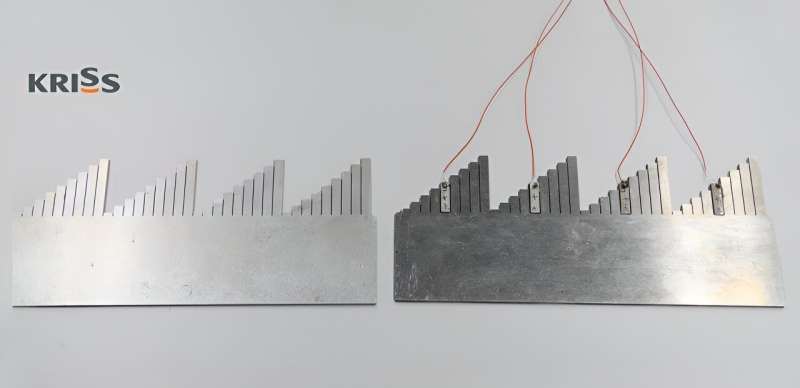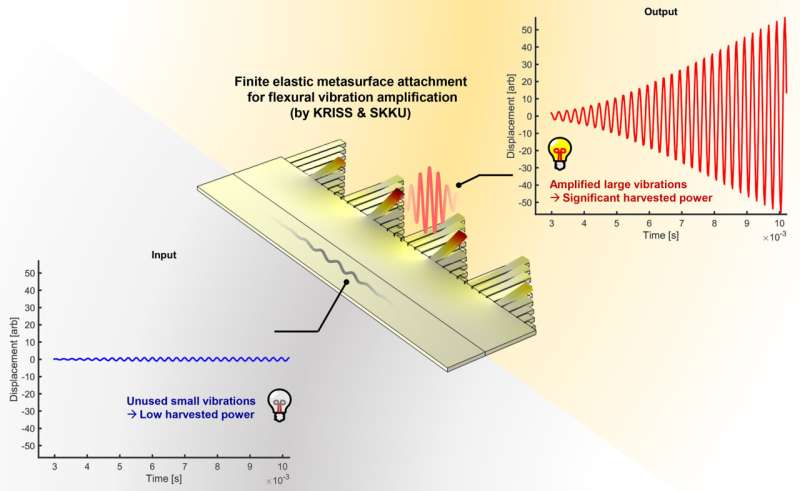This article has been reviewed according to Science X's editorial process and policies. Editors have highlighted the following attributes while ensuring the content's credibility:
fact-checked
trusted source
proofread
Harvesting unused micro-vibration to generate electricity

Energy Harvesting is a green technology that captures (or "harvests") wasted energy and converts it into electricity. The ubiquitous vibrations that surround us are one of the promising sources for energy harvesting. In particular, vibration energy harvesting has recently gained significant attention as a next-generation power supply technology because it can generate power consistently, unaffected by weather or terrain conditions.
The Korea Research Institute of Standards and Science (KRISS) has developed a metamaterial that traps and amplifies micro-vibrations in small areas. This innovation is expected to increase the power output of energy harvesting, which converts wasted vibration energy into electricity, and accelerate its commercialization. The paper is published in the journal Mechanical Systems and Signal Processing.
Energy harvesting refers to technology that converts wasted energy in the form of heat, light, and vibration into electrical energy. While solar power generation, which utilizes sunlight as its energy source, is commonly used, it poses limitations such as inconsistent output and the inability to generate power under certain weather and terrain conditions.
In contrast, utilizing ubiquitous vibrations as an energy source enables stable power generation without surrounding environmental constraints. This is why vibration energy harvesting continues to gain attention as a future source of power for Internet of Things (IoT) sensors that require a constant 24/7 power supply and wearable medical devices that should measure blood pressure and sugar levels in real time.

The main issues impeding vibration energy harvesting are that it has lower power output and higher production costs, making it a poor candidate for practical application. While the amount of power produced is proportional to the magnitude of the harvested vibration, most vibrations we encounter in daily life are tiny. To overcome this significant issue, numerous conversion devices, such as piezoelectric elements, should be installed in multiple locations that are exposed to relatively large vibrations.
The metamaterial developed by KRISS traps and accumulates micro-vibrations within it and amplifies them by more than 45 times. This allows the generation of large-scale electrical power relative to the small number of piezoelectric elements that are utilized. By applying vibration harvesting with the developed metamaterial, the research team has succeeded in generating more than four times more electricity per unit area than conventional technologies.
In particular, the newly developed metamaterial has a thin, flat structure roughly the size of an adult's palm, allowing it to be easily attached to any surface where vibration occurs. As its structure can be easily modified to fit the object to which it will be attached, its range of applications is diverse, from diagnostic sensors that check for damage in high-rise buildings or large bridges to small biosensors that monitor health conditions of individuals.
"This research is the first in the world to successfully accumulate and amplify vibrations using a surface metamaterial that temporarily traps vibrations," said Senior Researcher Lee Hyung Jin of the Acoustics, Ultrasound and Vibration Metrology Group at KRISS.
Senior Researcher Seung Hong Min of the Non-Destructive Metrology Group also expressed his interest, commenting, "Metamaterials can be used to develop next-generation high-precision and high-sensitivity sensors by greatly amplifying ultra-fine vibrations that were difficult to measure with conventional sensors."
More information: Hyung Jin Lee et al, Finite elastic metasurface attachment for flexural vibration amplification, Mechanical Systems and Signal Processing (2023). DOI: 10.1016/j.ymssp.2023.110996

















